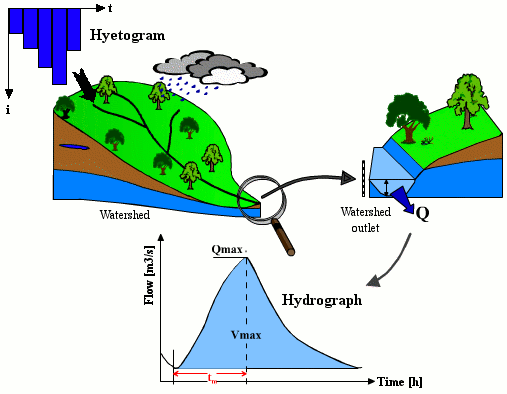
The way a catchment reacts when it is subjected to a rainfall event is called hydrological response.
 |
Figure 8.1 Hydrological response of a catchment [Musy, 2001]
A shower that falls on a catchment can have a powerful effect by modifying the flow regime. The hydrological response can be:
Hydrological response on a catchment is influenced by many factors that are related to:
The response of a catchment depends on the rainfall volume and the intensity variations during the rainfall. For a simple catchment, divided into four areas (A, B, C and D) of equal surface and delineated by isochrones, a variable flow time can be allocated for each sector (1 hour for zone A and 4 hours for zone D) (Linsley & Crowford, 1966).
 |
Figure 8.2 Catchment representation [Musy, 2001]
A rain with a volume of 10 mm constant for every case is considered.
Figure 8.3 presents three cases:
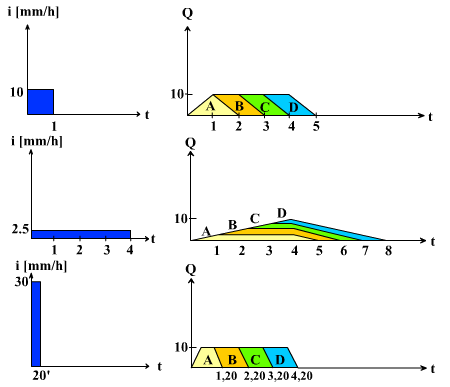 |
Figure 8.3 The rainfall influence in time,
on the hydrological response of a catchment
(Réménérias, 1976). Hyetograms are represented on the left
side, and hydrographs on the right side
It can be observed that there is a rainfall critical time when the peak flow is at its maximum.
The average rainfall of 10 mm / 1 hour is equally distributed over the catchment. Figure 8.4 shows the influence of shower spatial distribution over the hydrograph form. Hyetograms are represented on the left side, and hydrographs on the right side.
 |
Figure 8.4 The influence of rainfall spatial
distribution on
the hydrological response of a catchment [Musy, 2001]
The total rainfall of 10 mm / 1 hour is uniformly distributed over the catchment, but it is not equally distributed in time. Figure 8.5 shows the influence of intensity variations over the hydrograph form. Hyetograms are represented on the left side and hydrographs on the right side.
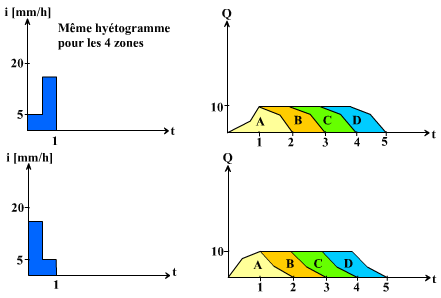 |
Figure 8.5 The influence of rainfall intensity
variations on
the hydrological response on a catchment [Musy, 2001]
The hydrologic response depends also on the initial hydric state of the catchment. In relating effective rainfall to surface runoff, the amount of effective rainfall depends on the state of the catchment before the storm event. If the ground is saturated or the catchment is impervious, then a high proportion of the rain becomes effective runoff. By absorbing rainfall an unsaturated ground has a certain capacity before responding to effective rainfall that contributes to the surface runoff. Once the ground deficiencies have been made up the rainfall becomes fully effective. In a second period of effective rain the response of the catchment will depend on the effects of the first input. An example for these cases is given in Figure 8.6.
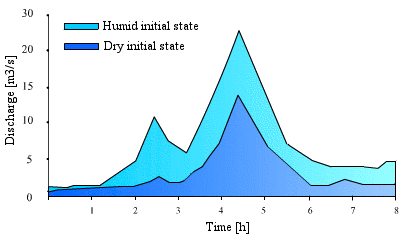
Figure 8.6 Influence of initial
humidity conditions on the
hydrograph's response of a catchment. [Musy, 2001]
A rainfall defined in time and space that falls on a catchment produces a hydrograph. Figure 8.7 defines certain essential elements of the hydrograph resulting from a hyetogram.
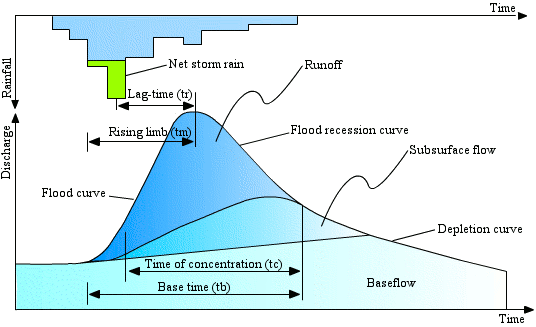
Figure 8.7 Hyetogram and hydrograph resulting from a storm event (rain - flow) [Musy, 2001]
To describe the processes that occur when the rain is transformed into a flow hydrograph (by Horton's postulate), we apply two functions called production function and transfer function. The production function allows determination of the net rain hyetogram starting from the total rain. The transfer function allows determination of the hydrograph resulting from the net rain. The net rain represents the part of total rain that contributes to the flow process.
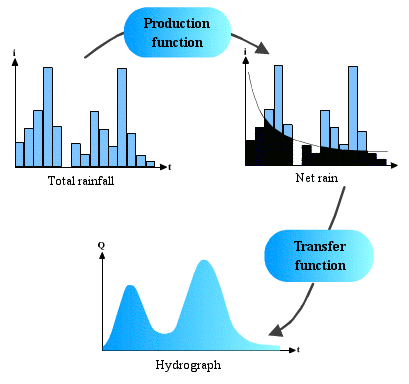 |
Figure 8.8 Transformation of total rain in hydrograph. [Musy, 2001]
The hydrograph is represented by an asymmetric curve. Peak flow is represented by the following formula:
 |
(8.1)
|
| where: | ||
| C | runoff coefficient (depends on the catchment characteristics) | |
| i | rainfall intensity in time tc | |
| A | area of catchment | |
It can be defined:
The hydrograph describes the whole time history of changing rate of flow from a catchment due to a rainfall event. It is essential to appreciate some of its simple components.
In Figure 8.7, rainfall intensity (i, in mm/h) is shown in discrete block intervals of time (t). The lower continuous curve of discharge (Q in m3/s) is the hydrograph resulting from the event. The discharge hydrograph is obtained from continuously recorded river levels and the level-discharge relationship appropriate to a river gauging station. The discharge hydrograph has two main components: the area under the hump, labelled surface runoff (which is produced by a volume of water derived from the storm event), and the broad band near the time axis, representing the baseflow.
At the beginning of the rainfall the river level is low and a period of time passes before the river begins to rise. During this period the rainfall is intercepted by vegetation or soaks into the ground, making up soil-moisture deficits. The length of the delay before the river rises depends on the humidity of the catchment before the storm and the intensity of the rainfall itself.
When the rainfall has made up catchment deficits and when surfaces and soil are saturated, the rain begins to contribute to the stream flow. The portion of rainfall that finds its way to a river is known as the effective rainfall, the rest being lost in evaporation, detention on the surface or retention in the soil. As the storm proceeds, the proportion of effective rainfall increases and the lost rainfall decreases.
The volume of surface runoff, represented by the upper area of the hydrograph minus the baseflow, can be considered in two main subdivisions in order to simplify the complex water movements over the surface and in the ground. Effective rainfall makes the immediate contribution to the rising limb unto the peak of the hydrograph and, even when rainfall ceases, it continues to contribute until the inflection point. Beyond this point, it is generally considered that the flow comes from water temporarily stored in the soil. This so-called interflow continues to provide the flow of the recession curve until water from the whole effective rainfall is completely depleted.
One final term, lag time, requires explanation. There are many definitions of lag, which is a measure of the catchment response time, but here it is considered from the gravity centre of the effective rainfall to the gravity centre of the direct surface runoff.
The boundary between surface runoff and baseflow is difficult to define and depends on the geological structure and composition of the catchment. During an individual rainfall event, the baseflow component of the hydrograph continues to go down even after river levels have begun to rise. Only when the storm rainfall has time to percolate down to the water table does the baseflow division curve begin to rise.
Unit Hydrograph
Unit hydrograph is the hydrograph of surface runoff resulting from a rain that falls in a unit of time (1 hour or 1 day) and produced uniformly in space and time over the total catchment area (Sherman, 1942).
In practice, a t hours unit hydrograph is defined as resulting from a unit depth of effective rainfall falling in t h over the catchment. The chosen magnitude for t depends on the size of the catchment and the response time to major rainfall events. The standard depth of effective rainfall was chosen by Sherman to be 1mm or 10mm.
The response hydrograph of a catchment varies according to the season: the same amount of effective rainfall will be longer in appearing as surface runoff in the summer season when vegetation is at its maximum development, and the hydraulic behaviour of the catchment will be "rougher". In countries with no marked seasonal rainfall or temperature differences and constant catchment conditions throughout the year, the unit hydrograph will be a much more consistent tool to use in deriving surface runoff from effective rainfall. Another weakness of the unit hydrograph is the assumption that effective rainfall is produced uniformly both in time and over the area of the catchment. Indeed, real distribution of rainfall within a storm is very rarely uniform. For small or medium size catchments (up to 500 km2), a significant rainfall event may extend over the whole area, and if the catchment is homogeneous in composition, even a fairly even distribution of effective rainfall may be produced. More often, storms that cause large river discharges vary in intensity, in space, as well as in time. The storm movement often affects the consequent response over the catchment area. Making T smaller can reduce the effect of variable rainfall intensities.
The unit hydrograph method has the advantage of great simplicity. Once a unit hydrograph of specified duration T has been derived for a catchment area, then, for any sequence of effective rainfalls in periods of T, an estimation of the surface runoff can be obtained by the simple properties outlined above. The technique was adopted and used worldwide for many years.
Many researchers from all over the world have studied extensions of the unit hydrograph principles. Dooge (1959) brought one of the most researched and fundamental contributions. Concentrating on linear mechanism, he suggested that the response of the catchment could be modelled by combining the storage effects with translation effects.
Further simplification of the Dooge approach using linear theory was also made by Diskin (1964) who modelled the catchment response by means of two series of equal linear reservoirs in parallel. Singh developed another linear catchment model, and showed that in practice it is possible to use simple geometrical forms instead of the real time-area curve. Kulandaiswamy produced a non-linear catchment response function using a non-linear storage expression and hence incorporated non-linear relationships that have been recognized for a long time as being more realistic in the description of a catchment's behaviour.
The unit hydrograph and its derivative models are mostly based on a single rainfall input, as usually an effective or excess rainfall after losses is deducted. Sometimes the input value comes from measurements of a single rain gauge or from the rainfall area over the catchment computed from several point rainfall measurements. In both cases a single value represents the catchment rainfall, which is called lumped input (Shaw, 1988).
Musy, A. 1998. Hydrologie appliquée, Cours polycopié d'hydrologie générale, Lausanne, Suisse.
Musy, A. 2001. e-drologie. Ecole Polytechnique Fédérale, Lausanne, Suisse.
Shaw, E. M. 1988. Hydrology in practice. Van Nostrand Reinhold International, London, United Kingdom.
Vladimirescu, I. 1978. Hidrologie. Ed. Didactica si Pedagogica, Bucuresti, Romania.